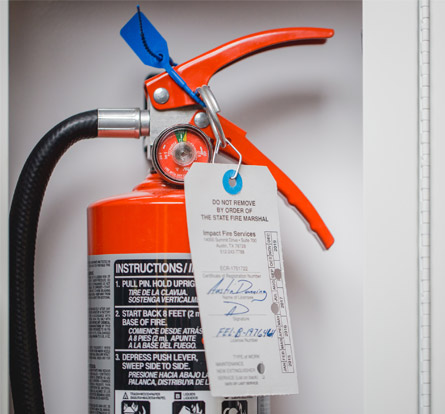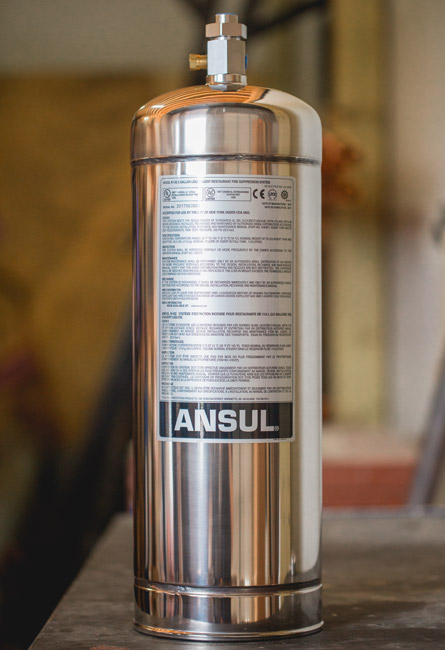
Academy Fire® inspects and services all types of fire extinguishers. We will review your facilities to ensure that your fire extinguishers fit the appropriate size, type, and placement to meet your needs and fire protection requirements. Properly maintained fire extinguishers operated by trained personnel save lives and prevent property damage. In accordance with National Fire Protection Association (NFPA) and state fire code, fire extinguishers shall be maintained annually and inspected monthly. If you operate facilities nationwide, you need a partner who can inspect and service your fire extinguishers no matter the location.
Working with Academy Fire®, you benefit from a single point of contact for your inspection, repair, design, installation, and retrofit services. Our rates are competitive, and our service is second-to-none. Our preventative maintenance program (PM) can ensure you are compliant and ready for any emergency. We sell and maintain all major brands and models of fire extinguishers. All commercial businesses have fire extinguishers and Academy Fire® has a program designed to meet your requirements.
Benefits

ACADEMY FIRE® CAN MANAGE YOUR FIRE EXTINGUISHER PM PROGRAM WITH:
- Recharge service
- Hydrostatic testing
- Service for all types of fire extinguishers
- 24/7 emergency ready
- Nationwide coverage
- National PM and service programs
- Dedicated account managers
- Automated custom reporting
- Dual coast call centers
- Direct wholesale distribution
- Inventory management
- Training classes
- Optional flat rate pricing
- Volume discounts
TYPES OF FIRE EXTINGUISHERS
DRY CHEMICAL
Dry chemical fire extinguishers put out the fire primarily by interrupting the chemical reaction of the fire. Today the most widely used type of fire extinguisher is the multipurpose dry chemical that is effective on Class A, B, and C fires. This agent also works by creating a barrier between the oxygen elements and the fuel element on Class A fires. Ordinary dry chemical is for Class B and C fires only. It is important to use the correct extinguisher for the type of fuel. Using the incorrect agent can allow the fire to reignite after apparently being successfully extinguished.
WATER AND FOAM
Water and foam fire extinguishers put out the fire by taking away the heat from the fire. Foam agents also separate the oxygen from the fuel and heat. Water extinguishers are for Class A fires only. They should never be used on Class B or C fires. The discharge stream could spread the flammable liquid in a Class B fire or could create a shock hazard on a Class C fire. Foam extinguishers can be used on Class A and B fires only.
CARBON DIOXIDE
These fire extinguishers put out the fire by separating the oxygen element of the fire triangle and by removing the heat with a very cold discharge. Carbon dioxide can also be used on Class B and C fires. They are usually ineffective on Class A fires.
WET CHEMICAL
Wet chemical extinguishers are a great new agent that extinguishes the fire by removing the heat from the fire and prevents re-ignition by creating a barrier between the oxygen and fuel elements. Wet chemical or Class K extinguishers were developed for modern, high efficiency deep fat fryers in commercial cooking operations.
HALOGEN OR CLEAN AGENT
Halogenated or clean agent extinguishers include the halon agents of old as well as the newer and more environmentally friendly halocarbon agents. They extinguish the fire by interrupting the chemical reaction and/or removing heat from the fire triangle. Clean agent extinguishers are effective on Class A, B, and C fires. Smaller sized handheld extinguishers are not large enough to obtain a 1A rating and may carry only a Class B and C rating.
DRY POWDER
Dry powder fire extinguishers are similar to dry chemical except that they extinguish the fire by separating the fuel from the oxygen element of the fire. However, dry powder extinguishers are for Class D or combustible metal fires only. They are ineffective on all other classes of fire.
WATER MIST
Water mist extinguishers are a recent development that extinguishes the fire by taking away the heat from the fire. They are an alternative to the clean agent extinguishers where contamination is a concern. Water mist extinguishers are primarily for Class A fires, although they are safe to use on Class C fires as well.
Maintenance Schedule
Every Year
- Maintenance on portable fire extinguishers.
Every 5 Years
- Hydrostatic test on carbon dioxide and water-based extinguishers.
Every 6 Years
- Maintenance on stored-pressure extinguishers.
Every 12 Years
- Hydrostatic test on stored pressure and cartridge-operated extinguishers.

Careers
Academy Fire is a great place to grow your career. Join our account support team and become an industry expert. Contact us today and learn more about the Academy Fire family.

Contact US
Learn more about the benefits of partnering with Academy Fire for your fire and life safety needs. Our account teams are available 24/7 365 to provide the support you require no matter where your sites are located.


